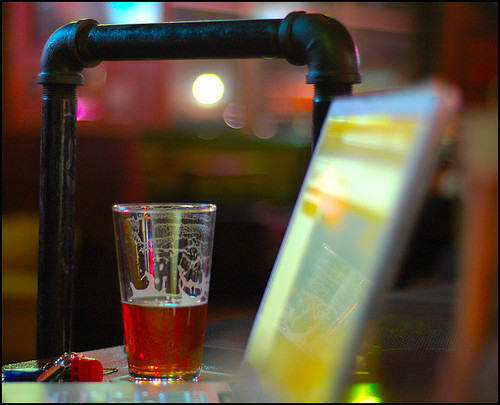More notes from yesterday’s SXSW panels, this time Designing the Future of the New York Times:
Tom Bodkin, Assistant Managing Editor, Design Director, NYT and Khoi Vinh, Design Director of NYT.com
Tom Bodkin art director background, traditional print.
Joined NYT in 1980.
Works with Razorfish on the redesign of the website. Removed the underscores from hyperlinks.
The Times Reader, worked on the project.
What does the future looks like – no one knows for sure. Publishing in period of rapid change. Imperative to make newspapers webby is counterproductive. Print experience appealing in world that offer ubiquitous Internet access. Shouldn’t try and recreate the web in print. Have to focus on benefits. Disposable, easy to share, narrative flow, you know where you are, fully consumed and finished, durable, don’t run out of batteries, serendipity and manageable quality of content invites perusal ids more so than the internet I DON’T THINK SO!
Persistence a newspaper you can put aside and it won’t have changed. Regular schedule. Natural physical object is not ephemeral and has a place in time and history.
Attribute distinguish it from the web and make it a pleasurable experience. (ISN’T THE WEB PLEASURABLE?!)
Better to retain print qualities in print than mimic the web on print.
Khoi: Runs subtraction.com – basic design blog. Formed design company then left in 2006 to join NYT.
Had a career in print and had originally translated that into the web.
Paradox to digital design is that it’s easy to publish and communicate ideas worldwide but once publish it the obligation to continue to publish is greater than that in print.
Editorial layout of content and stories that we see on NYT.com is very expensive and in terms of economics the reverse ordering of content is the most natural way to publish online.
Evolution thinking I could do things in print than online to moving towards text-based reverse chronological posts,.
Need for high quality journalism is there. Citizen journalism is not a high quality replacement. You will have thousands of micropublishers out there and a handful of global news platforms. In order to become on of the global news platforms have to reconsider the traditional approaches to journalism. Everyone at the Times is trying to figure this out. We are trying to look at us creating a platform to help us make the most of our content. At the same time we believe our content should be platform agnostic. We have a mobile site, iphone app,
Work with Amazon on the Kindle product. Tech group have enabled widgets and APIs to allow content to be pulled onto other pages. 10 APIs released in the past year.
There are a lot of groups at the times engaged in design activities and our group are not focused on designing the news and we’re trying to think about what’s the whole platform experience. So the interactive maps and immersive community experiences tied to news stories, we’re not working on thes on a daily basis we’re creating a tololbox so the infographics team working on a tight turnaorund trying to publish within minutes they have a toolbox for them to draw upon.
When there are events with a long enough lead time we try to get involved in it.
Pogueomatic = collaborative example.
Year in Ideas is another.
Enterprise reporting is extensive and investigative journalism we will help plan microsites, eg. environmental situation in China. Provide cohesive experience including audio, video, interactive graphics and Chinese translation.
Creating more interactive experiences, e.g. Best Picture Oscar ballot. March Madness “The Men’s Bracket” allowing you to create own groups and compete against friends.
Evergreen features of functionality is main focus.
Keepers of the style guide.
Focused on the navigation, on the shell of the site.
Blogs is a huge part of the design group a few dozen blogs on NYT. Work with journalists to brainstorm their blog and develop a brand Cityroom – one of the best performing blogs.
Worked on TimesMachine a visual archive of every page between 1851 and 1925 – every single page – rollover and abstract and then go see article itself.
Bodkin: Web is limited in the way that you can design with it. Very little conceptual thinking. 19th century newspaper thinking in some pages were as much material is put on that page as possible.
What I see on the web is an engineering model,. a business school model where I am used to a more creative process. Is the reliance on metrics and testing versus on dependence on personal vision which you see in the nature of print driving the nature of digital.
Vinh: web is very conversational in nature and requires engineering to provide an environment that is natural to them and are not in sync in the way an editor or art director would want to use the content.
Bodkin: behaviour on the web is different but I wonder whether it’s a function of where the web is now in its evolution and will the availability of handheld
Bodkin: Serendipity hasn’t been a priority, but could be achieved.
Vinh would like to increase the serendipity of NYT.
People get more serendipity today than you would ever get on a newspaper. Spending time on the blogs. Grander schemes of things probably narrower than it is in the newspapers.

